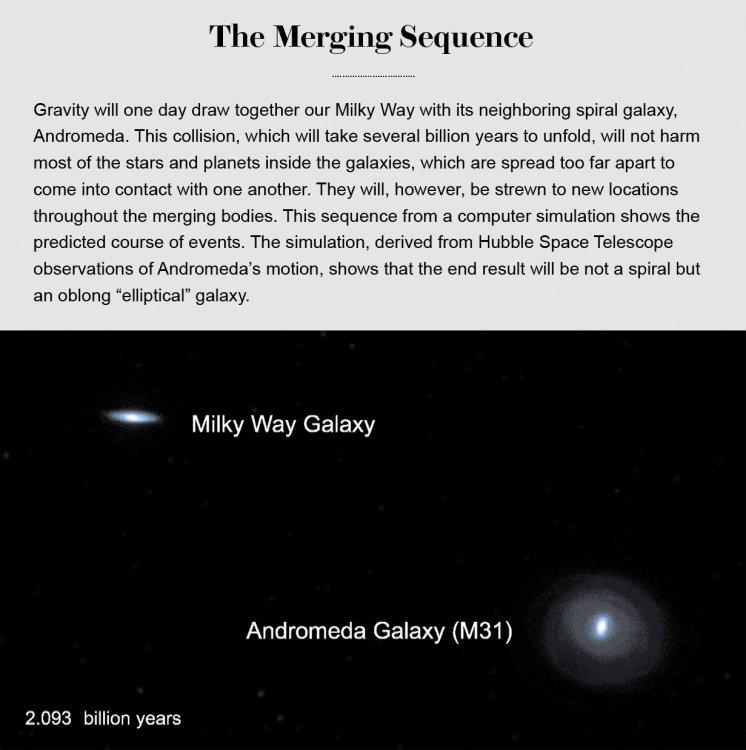Observations and calculations show that the Milky Way will collide with its nearest neighbor in the local cluster, the Andromeda Galaxy, in four billion years. Such a merger of large galaxies can last for several billion years. However, one should not expect the brightest destructive explosions from such a convergence. As a rule, a galaxy merger occurs without any star collisions, as the distance between stars is too long. Meanwhile, some stars will be ejected to the periphery of the galaxy, while gas and dust will be drawn to the approaching cores destroying the spiral arms of the two galaxies. What will happen to the Andromeda and Milky Way Galaxies? Corresponding Member of the Russian Academy of Sciences (RAS) Alexander Ivanchik answers these questions.
Alexander V. Ivanchik — RAS Corresponding Member, Leading Researcher at Ioffe Physico-Technical Institute, RAS.
— Space seems to be a static expanse where nothing happens over several hundred light years. Is it true?
— Of course, it is not true. If you study the starry sky for a long time, you will notice that the stars are actually moving. Ancient people also noticed this phenomenon, but they interpreted these changes as the movement of crystal spheres with stars fixed on them. Later, scientists realized that the movement of stars in the sky was associated with the Earth’s rotation.
If you exclude the Earth’s rotation and try to track the position of stars in the sky, of course, most of them look static. The reason is that space objects are so far away from us that their actual movement is barely noticeable. Nevertheless, several centuries ago, when astronomers initiated systematic observations, they found out that stars did change their position in the sky as they moved in space.
Two centuries ago, when observing the brightest star in the night sky, Sirius, famous German mathematician Friedrich Wilhelm Bessel noticed that, apart from its stationary motion, the star also changed its position from time to time. Bessel suggested that Sirius was actually a binary star system, which was confirmed afterward.
Consequently, systematic observations of space object motion began several centuries ago. Thus, the scientific community knows for certain that stars move and change their positions relative to each other as well as galaxies that can be considered star islands.
The motion of galaxies was discovered about 100 years ago. Nothing was known about galaxies at that time. People believed that our Milky Way was the only existing galaxy inside which various nebulas were observed. This is partially true, as there are indeed many different nebulas in the galaxy. However, in 1914, American astronomer Vesto Melvin Slipher noticed that some of them were too far away from us. By measuring the supposed nebulas’ redshift, scientists realized that they were moving quite fast. Later, astronomer Edwin Hubble guessed that they were not nebulas but other galaxies far beyond the Milky Way.
In particular, it was discovered that Andromeda, which was considered a nebula at that time, was in fact a quite large galaxy moving towards the Milky Way at a speed of about 120 km/s. When scientists realized that it was the closest galaxy to us, it became clear that Andromeda and the Milky Way were gravitationally connected. It is assumed that sooner or later both galaxies will come so close to each other that they are likely to collide.
The motion of more distant galaxies is not that obvious. It is extremely hard to spot their actual motion during the interval of human civilization’s existence. However, we know for sure that they are moving. Scientists use the Doppler effect to measure the speed of these galaxies. In addition to their own speed of motion in space, they also have the Hubble speed measured by the cosmological redshift in the spectra of these galaxies. The Hubble expansion of the Universe makes galaxies move away from each other, which is also confirmed by measurements.
The Universe is very non-static; it comprises a vast number of different motion patterns. Everything moves, including stars, galaxies, and even galactic clusters. At the same time, we can determine the speed of motion in space using relic radiation that uniformly and evenly fills the Universe. For example, we were able to determine our own galaxy’s speed of motion in space relative to this radiation, and it amounted to about 600 km/s.
— This speed is quite high, isn’t it?
— Yes, it is. However, compared to the Hubble speed of distant galaxies in our expanding Universe, that is, relativistic speed measured in the speed of light, this speed is quite low.
— We will discuss the Milky Way and Andromeda merger a bit later. In general, how often do galaxy mergers occur in the Universe?
— It depends on the timeframe of the observation. The matter of the Universe was distributed uniformly immediately after the Big Bang. As gravitational instabilities were increasing, stars and galaxies began to form, and it is only from that moment that they could merge. At the same time, the size of the Universe and the distances between objects were much smaller than now in those distant times, so the merger rate of forming galaxies was higher than today. On the contrary, if we look into the future, under current conditions of the expanding Universe, galaxies receding from each other will merge less and less often.
Overall, the characteristic time of galaxy mergers is comparable to the age of the Universe, that is, it is about several dozens of billions of years. Small, dwarf galaxies gravitationally bound to larger ones merge on a scale of about several billion years. Large galaxies, such as Andromeda and the Milky Way that have already absorbed dwarf galaxies, merge less frequently — on a scale of approximately 10 billion years. In other words, galaxy mergers occurred more often in the past.
The point is that the “galaxy merger” is a conditional term, as a merger often does not take place during the first collision. Sometimes galaxies pass through each other without merging since they are still very rarefied systems. The distance between stars in galaxies is huge compared to the size of stars. Consequently, galaxies can often pass through each other without collisions between stars and planets. However, after all, tidal gravitational forces distort the shapes of galaxies, and the gas and dust present in galaxies cling to each other, which eventually leads to a merger into one large galaxy.
— Are there any models to predict how this collision occurs? How devastating can a merger be for two galaxies?
— Yes, such models exist. The advent of powerful supercomputers allowed scientists to learn how to simulate such phenomena. In fact, images obtained from telescopes capture only static moments of approaching galaxies, their merger, and destruction. However, we need calculations to understand what happens during a merger and how galaxies move relative to each other, and you cannot do these calculations on a regular computer.
Simulation of the Galactic Collisions
— What do we know today about the future merger of the Milky Way and Andromeda?
— Let me remind you that Andromeda and the Milky Way are the two largest galaxies in the local group. The galaxies are in gravitational connection with each other and bind a vast number of satellite dwarf galaxies. In the early 20th century, scientists calculated the speed of Andromeda towards the Milky Way using the blueshift in the Doppler effect. Knowing the speed and distance to Andromeda (approximately 2.5 million light years), we can estimate when the two galaxies may come so close to each other that the gravitational interaction will start to affect each of them. A galaxy merger will begin from this moment. Scientists say it will happen in about four billion years.
There are different opinions about what the Milky Way and Andromeda merger will look like. They believe that it will occur with practically no collisions between the stars and planets of the two galaxies. The gravitational tidal destruction of the galactic disks will form a giant elliptical galaxy. It is assumed that elliptical galaxies were formed specifically during the mergers of spiral galaxies. Supercomputer calculations demonstrate that it is one of the most likely scenarios for Andromeda and the Milky Way.
As I have already said, the merger will be imperceptible for most stars. A head-on collision is unlikely due to their practically corpuscular dimensions on a galaxy scale. Nevertheless, some stars will pass by each other at very close distances and acquire high speeds, so they can be thrown out to the periphery or even beyond the boundaries of their galaxy.
One of such scenarios was modeled for our Solar System. However, modern calculations still depend largely on multiple circumstances. Modeling such large-scale processes is an extremely difficult task, so no one can guarantee that this or that forecast becomes a reality. The slightest shift in the initial conditions can fundamentally change the result for a single star or system. However, such calculations are quite credible for galaxies in general.
— We know that there is a massive black hole in the center of the Milky Way Galaxy and we have recently obtained its image. What happens to black holes during such mergers?
— Now most scientists agree that there is a supermassive black hole in the center of almost every galaxy. Galaxy observations confirm this theory. The black hole in the center of the Milky Way is supermassive, but it is not the largest one among such objects. Its mass is approximately four million solar masses, while the masses of supermassive black holes found in the active cores of other galaxies can reach several billion solar masses. That is, they can be one thousand times more massive than the one in the center of our galaxy.
If a head-on collision between the Milky Way and Andromeda occurs, supermassive black holes can also merge due to gravitational waves. In this scenario, the mass of the combined supermassive black hole will increase.
Also, there is a scenario where a collision takes place with a large impact parameter. In this case, a gravitational capture will form a stable orbit of two rotating black holes that will be rotating for a very long time. Such double black holes can exist in galaxies.
— What do we get from studying the galaxy merger process?
— Research studies into this process are fundamental. Above all, they allow us to better understand galaxy formation peculiarities. After all, a galaxy merger is one of the most important aspects of changes in the galactic structure and increase in their mass. Consequently, it is an important aspect of changes in their classification. Spiral and lenticular galaxies become elliptical. At the same time, galaxy mergers initiate one of the most important processes — star formation. For example, star formation processes are quite active in early galaxies. However, they fade away with time and go at a lower rate as they do in the Milky Way now, for instance. Therefore, any external influence, including mergers, leads to the emergence of new gas — a material to form new stars. Due to galactic structure perturbation, interstellar gas clouds lose their stability, and so bursts of star formation occur. These bursts, in turn, change the chemical composition of galaxies.
— What equipment do scientists use to study galaxy mergers and evolution?
— Of course, astronomers mainly obtain information using telescopes. Modern telescopes have different forms. First of all, there are optical telescopes that appeared in the days of Galileo. We obtained most of the information on galaxies using optical telescopes.
Orbiting telescopes, such as Hubble and Webb, are equally important for studies. The atmosphere of the Earth distorts images. There is no distortion in orbit, so Hubble captures very deep and clear pictures of galaxies and other space objects.
In addition to the optical range, galaxies are actively studied within the radio and X-ray ranges. X-ray observatories keep watch over galaxies, X-ray sources, galactic clusters, and processes in the centers of galaxies with quasars.
Modern astronomers and astrophysicists have more and more opportunities to observe any space objects, including galaxies. New data help us better understand the physics of processes in the Universe as well as the nature of what is happening in space objects, including galaxies.
— Is it true that galaxy mergers are the brightest phenomena in the Universe? What gives this luminosity?
— It is not entirely true. Mergers can be called one of the most beautiful events, but they are still not the brightest phenomena. The brightest and the most distant sources observed are quasars and supernova explosions. When a star explodes, a huge amount of energy is released. We can observe such events for several months in the optical range. At the peak of its luminosity, that is, at the moment of explosion, the luminosity of a supernova exceeds that of all stars in the parent galaxy. In simple words, sometimes such a star is dozens and hundreds of times brighter than the entire galaxy.
— Mr. Ivanchik, what are you working on at the moment?
— My field of study is cosmology, the science concerned with the structure and evolution of the Universe. The birth and evolution of galaxies and changes in their chemical composition are processes that take place in cosmological time, so they all are tied to cosmology. For example, changes in the chemical composition of galaxies are a very interesting cosmological problem. Determining primary deuterium, primary helium, and primary lithium helps us estimate the amount of ordinary, baryonic matter in the Universe. Modern estimates show that it amounts to only 5% of the substance that fills the Universe, while 95% accounts for dark matter and dark energy, the nature of which remains unknown.
During the first minutes after the Big Bang, the so-called primary nucleosynthesis took place to form the initial chemical and isotopic composition of our Universe. The primary composition is quite simple: about 90% by the number of atoms is hydrogen, and 8% by the number of atoms is helium. All other elements are in absolutely negligible quantities. The formation of galaxies and the birth of stars in them lead to the evolution of chemical composition.
For example, hydrogen and helium gradually burn out into heavier elements in stars. Exploding stars enrich the interstellar medium. The evolution of galaxies results in intergalactic gas enrichment. If we understand the described processes, we can evaluate the chemical composition, compare it with the prediction of primordial nucleosynthesis, and, consequently, determine one of the key cosmological parameters — the baryon density of the Universe.
The second important aspect of cosmology in the context of galaxy evolution is associated with the Universe's expansion rate. It expands at a variable rate. Furthermore, we know that the expansion rate of the Universe slowed down after the Big Bang. However, several billion years after the Big Bang, an event changed the expansion rate of the Universe, and it began to expand with acceleration. This, in turn, impacts the formation of galaxies and galactic clusters.
— What kind of event could increase the Universe's expansion rate?
— We believe that there is some cosmic energy in the Universe, dark energy, as it is most often called nowadays. This energy creates anti-gravity. The nature of this form of matter is currently unknown. The word “matter” is quite conditional, as it can be modified gravity or a manifestation of our Universe's multidimensionality. The scientific community offers various interesting assumptions in this regard which require verification and confirmation. Thanks to observations, we know for certain that the Universe is expanding at an increasing rate, but we have yet to find out the cause of this phenomenon. This is one of the most important cosmological mysteries of our time.
The interview was conducted with the support of the Ministry of Science and Higher Education of the Russian Federation and RAS.





























